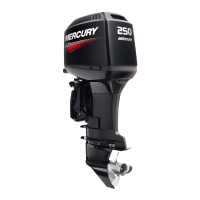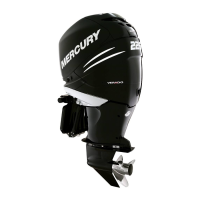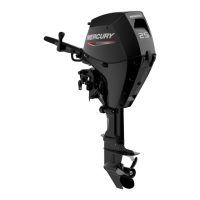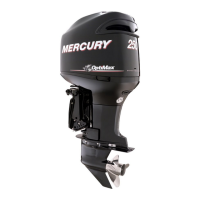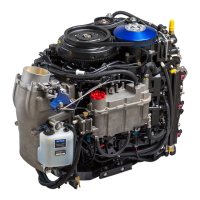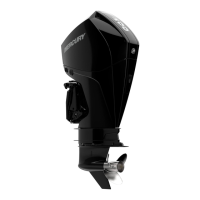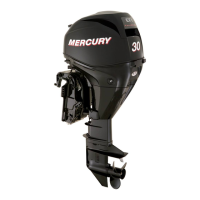90-10100R30
8
GB
gob3
ob
GENERAL INFORMATION
obh1
PROTECTING PEOPLE IN THE WATER
While You are Cruising
It is very difficult for a person standing or floating in the water to take quick action
to avoid a boat heading in his/her direction even at slow speed.
Always slow down and exercise extreme caution any time you are boating in an
area where there might be people in the water.
While Boat is Stationary
Shut off the engine before allowing people to swim or be in the water near your
boat.
WARNING
Stop your engine immediately whenever anyone in the water is near
your boat. Serious injury to the person in the water is likely if con-
tacted by a rotating propeller, a moving boat, a moving gear case, or
any solid device rigidly attached to a moving boat or gear case.
gob4
Courtesy of ABYC
1
obi2
EXHAUST EMISSIONS
Be Alert To Carbon Monoxide Poisoning
Carbon monoxide is present in the exhaust fumes of all internal combustion
engines including the outboards, stern drives and inboard engines that propel
boats, as well as the generators that power various boat accessories. Carbon
monoxide is a deadly gas that is odorless, colorless and tasteless.
Early symptoms of carbon monoxide poisoning which should not be confused with
seasickness or intoxication, include headache, dizziness, drowsiness, and
nausea.
WARNING
Avoid the combination of a running engine and poor ventilation. Pro-
longed exposure to carbon monoxide in sufficient concentration can
lead to unconsciousness, brain damage, or death.
Good Ventilation
Ventilate passenger area, open side curtains, or forward hatches to remove
fumes.
1 Example of desired air flow through the boat.
gob39
a
c
b
d
2
obi3
EXHAUST EMISSIONS (CONTINUED)
ob
Poor Ventilation
Under certain running and/or wind conditions, permanently enclosed or canvas
enclosed cabins or cockpits with insufficient ventilation may draw in carbon
monoxide. Install one or more carbon monoxide detectors in your boat.
Although the occurrence is rare, on a very calm day, swimmers and passengers
in an unclosed area of a stationary boat that contains or is near a running engine
may be exposed to a hazardous level of carbon monoxide.
2 Examples of Poor Ventilation:
While boat is stationary
a. Running the engine when the boat is moored in a confined space.
b. Mooring close to another boat that has its engine running.
While boat is moving
c. Running the boat with the trim angle of the bow too high.
d. Running the boat with no forward hatches open (station wagon effect).
obj2
SELECTING ACCESSORIES FOR YOUR OUTBOARD
Genuine Mercury Precision or Quicksilver Accessories have been specifically
designed and tested for your outboard. These accessories are avialable from
Mercury Marine dealers.
Some accessories not manufactured or sold by Mercury Marine are not designed
to be safely used with your outboard or outboard operating system. Acquire and
read the installation, operation, and maintenance manuals for all your selected
accessories.
WARNING
Check with your dealer before installation of accessories. The misuse
of acceptable accessories or the use of unacceptable accessories can
result in serious injury, death, or product failure.
obk1
SAFE BOATING SUGGESTIONS
In order to safely enjoy the waterways, familiarize yourself with local and other
government boating regulations and restrictions, and consider the following
suggestions.
Use flotation devices. Have an approved personal flotation device of suitable
size for each person aboard (it is the law) and have it readily accessible.
Do not overload your boat. Most boats are rated and certified for maximum load
(weight) capacities (refer to your boat capacity plate). If in doubt, contact your
dealer or the boat’s manufacturer.
Perform safety checks and required maintenance. Follow a regular schedule
and ensure that all repairs are properly made.
Know and obey all nautical rules and laws of the waterways. Boat operators
should complete a boating safety course. Courses are offered in the U.S.A. by (1)
The U.S. Coast Guard Auxiliary, (2) The Power Squadron, (3) The Red Cross and
(4) your state boating law enforcement agency. Inquiries may be made to the
Boating Hot-line, 1-800-368-5647 or the Boat U.S. Foundation information number
1-800-336-BOAT.
Make sure everyone in the boat is properly seated. Don’t allow anyone to sit
or ride on any part of the boat that was not intended for such use. This includes
backs of seats, gunwales, transom, bow, decks, raised fishing seats, any rotating
fishing seat; anywhere that sudden unexpected acceleration, sudden stopping,
unexpected loss of boat control or sudden boat movement could cause a person
to be thrown overboard or into the boat.
Never be under the influence of alcohol or drugs while boating (it is the law).
They impair your judgment and greatly reduce your ability to react quickly.
Prepare other boat operators. Instruct at least one person on board in the basics
of starting and operating the outboard and boat handling in case the driver
becomes disabled or falls overboard.
Passenger boarding. Stop the engine whenever passengers are boarding,
unloading or are near the back (stern) of the boat. Just shifting the outboard into
neutral is not sufficient.
Be alert. The operator of the boat is responsible by law to “maintain a proper
lookout by sight (and hearing).” The operator must have an unobstructed view
particularly to the front. No passengers, load, or fishing seats should block the
operators view when operating the boat above idle speed.
Never drive your boat directly behind a water skier in case the skier falls.
As an example, your boat traveling at 25 miles per hour (40 km/hr) in 5 seconds
will overtake a fallen skier who was 200 feet (61m) in front of you.
Watch fallen skiers. When using your boat for water skiing or similar activities,
always keep a fallen or down skier on the operator’s side of the boat while returning
to attend the skier. The operator should always have the down skier in sight and
never back up to the skier or anyone in the water.
Report accidents. Boat operators are required by law to file a Boating Accident
Report with their state boating law enforcement agency when their boat is involved
in certain boating accidents. A boating accident must be reported if (1) there is loss
of life or probable loss of life, (2) there is personal injury requiring medical treatment
beyond first aid, (3) there is damage to boats or other property where the damage
value exceeds $500.00 or (4) there is complete loss of the boat. Seek further
assistance from local law enforcement.

